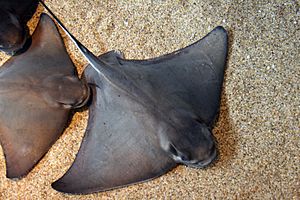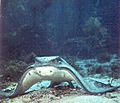Bat ray facts for kids
Quick facts for kids Bat ray |
|
|---|---|
 |
|
| Conservation status | |
| Scientific classification | |
 |
|
| Range map |
The bat ray (Myliobatis californica) is an eagle ray found in muddy or sandy sloughs, estuaries and bays, kelp beds and rocky-bottomed shoreline in the eastern Pacific Ocean, between the Oregon coast and the Gulf of California. It is also found in the area around the Galápagos Islands. The largest specimens can grow to a wingspan of 1.8 m (5 ft 11 in) and a mass of 91 kg (201 lb). They more typically range from 9.07–13.61 kg (20.0–30.0 lb). The size of the bat ray is dependent on many factors, such as habitat alterations, different oceanographic and environmental conditions. Bat rays have one to three venomous barbed spines at the base of its tail.
The sexual maturity size of the female Myliobatis california is often greater than the male one. Bat rays are euryhaline, i.e. they are able to live in environments with a wide range of salinities. Predators of the Bat ray include California sea lion, Great white sharks and broadnose sevengill sharks
Diet
Bat rays feed on mollusks, crustaceans and small fish on the seabed, using their winglike pectoral fins to move sand and expose prey animals. They may also dig trenches up to 20 cm deep to expose buried prey, such as clams. Bat ray teeth are flat and pavementlike, forming tightly-packed rows that are used for crushing and grinding prey—the crushed shells are ejected and the flesh consumed. As with all elasmobranchs, these teeth fall out and are replaced continuously.
Relationship with humans
While the bat ray, like other stingrays, has a venomous spine in its tail (near the base), it is not considered dangerous and uses the spine only when attacked or frightened.
Currently, the bat ray is fished commercially in Mexico but not the United States. Prehistorically, native tribes on the California coast (probably Ohlone), especially in the San Francisco Bay area, fished bat rays in large numbers, presumably for food.
Commercial growers have long believed bat rays (which inhabit the same estuarine areas favored for the industry) prey on oysters and trapped them in large numbers. In fact, crabs (which are prey of bat rays) are principally responsible for oyster loss. Bat rays are not considered endangered or threatened.
Bat Rays are popular in marine parks, and visitors are often allowed to touch or stroke the ray, usually on the wing.
Life cycle
Bat ray reproduction is ovoviviparous. They mate annually, in the spring or summer, and have a gestation period of nine to twelve months. Litter sizes range from two to ten — pups emerge with their pectoral fins wrapped around the body, and the venomous spine is flexible and covered in a sheath which sloughs off within hours of birth. Bat rays live up to 23 years.
Bat rays copulate while swimming with synchronized wingbeats—the male under the female. The male inserts a clasper into the female's cloaca, channeling semen into the orifice to fertilize her eggs.
Gallery
See also
 In Spanish: Myliobatis californica para niños
In Spanish: Myliobatis californica para niños






